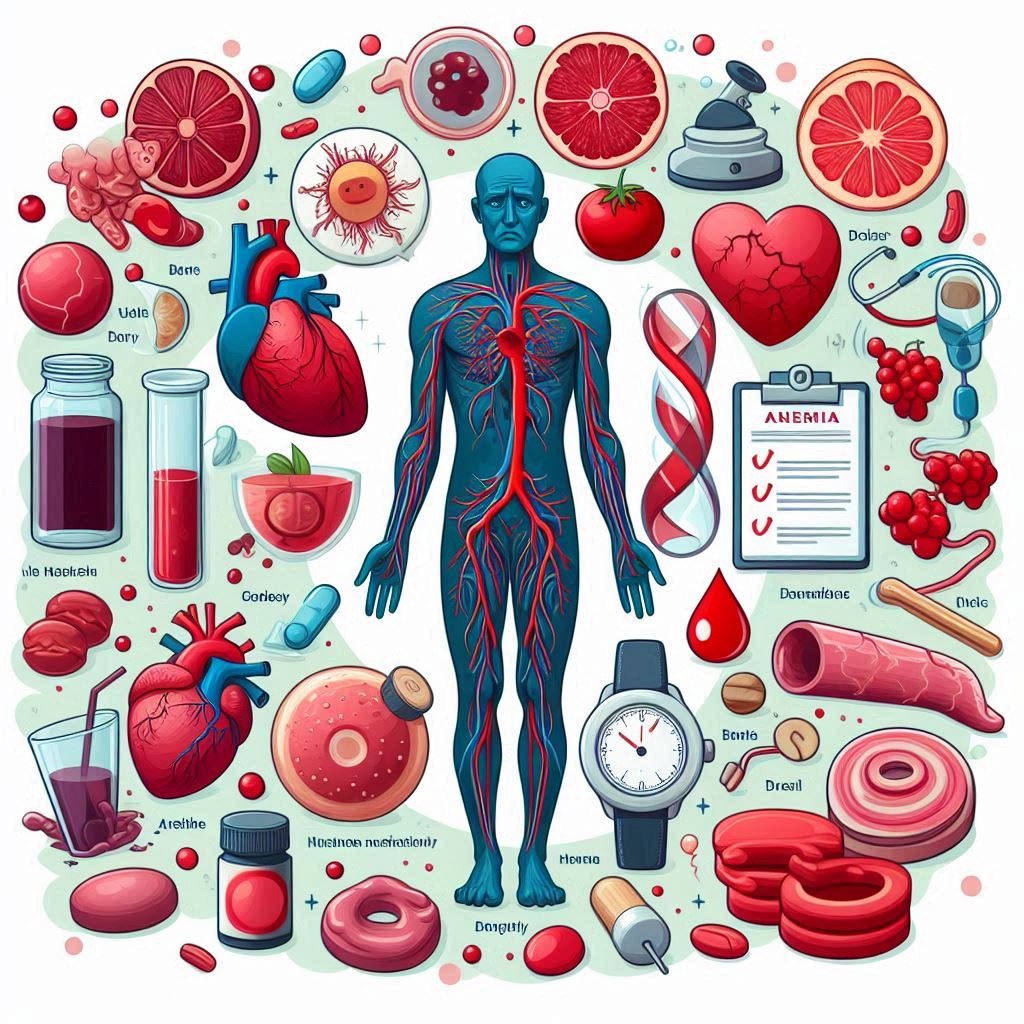Anemia: Causes, Symptoms, Nutritional Requirements & Treatment

Anemia is a common condition that affects millions of people worldwide. It is characterized by a deficiency of red blood cells or hemoglobin, leading to reduced oxygen transport in the body. Understanding the causes, symptoms, and nutritional requirements of anemia is essential for effective management and treatment.
This article will explore various aspects of anemia, including its symptoms, different types, potential causes, diagnostic methods, treatment options, prevention strategies, and nutritional necessities.
What are the symptoms of anemia?
Identifying the symptoms of anemia is crucial for early diagnosis and treatment. Common anemia symptoms in women and men may include:
- Fatigue and weakness
- Pale skin and dizziness
- Shortness of breath during physical activities
- Cold hands and feet
- Rapid or irregular heartbeat
These symptoms may vary in intensity depending on the severity of anemia. Individuals often report feeling unusually tired or weak, which significantly impacts their daily activities and quality of life.
Other symptoms can include headaches, difficulty concentrating, and even hair loss. In some cases, people may experience restless leg syndrome or unusual cravings for non-food items, a condition known as pica.
What are the different types of anemia?
There are several types of anemia, each with distinct causes and characteristics. The most common types include:
- Iron-deficiency anemia: This occurs due to a lack of iron, essential for hemoglobin production.
- Vitamin B-12 deficiency anemia: This type arises when the body lacks vitamin B-12, crucial for red blood cell formation.
- Folate deficiency anemia: Folate, or vitamin B-9, is necessary for proper cell division, and its deficiency can lead to anemia.
- Aplastic anemia: A rare condition where the bone marrow fails to produce sufficient blood cells.
- Hemolytic anemia: This occurs when red blood cells are destroyed faster than they can be produced.
Understanding these types is essential for identifying the underlying causes and implementing appropriate treatment strategies.
What causes iron-deficiency anemia?
Iron-deficiency anemia is the most prevalent form of anemia, primarily caused by insufficient iron levels in the body. Common causes include:
- Poor dietary intake of iron-rich foods
- Increased iron needs during pregnancy and growth spurts
- Blood loss due to menstruation, surgery, or gastrointestinal bleeding
Inadequate absorption of iron due to certain medical conditions, like celiac disease or inflammatory bowel disease, can also contribute to this type of anemia. Moreover, individuals with a history of heavy menstrual periods or those who donate blood frequently may be at higher risk.
Recognizing the causes of iron-deficiency anemia is crucial for developing effective prevention and treatment plans.
How is anemia diagnosed?
Diagnosis of anemia typically involves a combination of medical history, physical examination, and laboratory tests. The most common tests include:
- Complete blood count (CBC): Measures levels of red blood cells, hemoglobin, and hematocrit.
- Reticulocyte count: Assesses bone marrow activity and red blood cell production.
- Iron studies: Evaluates iron levels in the blood, including ferritin and transferrin saturation.
In some cases, additional tests may be required to identify underlying causes, such as vitamin deficiency tests or bone marrow biopsies. Early diagnosis is vital to prevent complications and initiate appropriate treatment.
How is anemia treated?
Treatment for anemia depends on the underlying cause. Common approaches include:
- Dietary changes: Increasing the intake of iron-rich foods, such as red meat, leafy greens, and legumes.
- Supplements: Iron supplements or vitamin B-12 injections may be prescribed to address deficiencies.
- Medical interventions: In severe cases, blood transfusions or medications may be necessary.
It is essential to consult with a healthcare provider for an accurate diagnosis and personalized treatment plan.
How is anemia prevented?
Preventing anemia involves maintaining a healthy diet and lifestyle. Some effective strategies include:
- Consuming a balanced diet rich in iron, vitamin B-12, and folate.
- Avoiding excessive blood loss through proper medical care and monitoring.
- Regular check-ups, especially for individuals at risk, such as pregnant women or those with chronic diseases.
Education about the importance of nutrition and recognizing early symptoms can significantly reduce the risk of developing anemia.
What are the nutritional requirements for anemia?
To effectively manage and prevent anemia, it is crucial to meet specific nutritional requirements. Key nutrients include:
- Iron: Essential for hemoglobin production; sources include red meat, beans, and fortified cereals.
- Vitamin B-12: Necessary for red blood cell formation; found in animal products like meat, eggs, and dairy.
- Folate: Important for DNA synthesis and cell division; abundant in leafy greens, legumes, and citrus fruits.
Incorporating these nutrients into your diet can help maintain healthy red blood cells and support overall well-being.
What are the requirements for anemia?
The requirements for managing anemia typically include a balanced intake of essential nutrients, particularly iron, vitamin B-12, and folate. These nutrients play a vital role in producing healthy red blood cells and ensuring optimal oxygen transport throughout the body. Regular monitoring of nutrient levels, especially for individuals at risk, is also crucial.
What are the causes of anemia?
Anemia can arise from various factors, including nutritional deficiencies, chronic diseases, genetic conditions, and blood loss. Common causes include iron deficiency due to poor diet, vitamin B-12 deficiency from malabsorption, and chronic illnesses that affect red blood cell production. Understanding these causes is essential for effective management and prevention.
What are 5 symptoms of anemia?
Five common symptoms of anemia include:
- Fatigue and weakness
- Pale or jaundiced skin
- Shortness of breath
- Cold extremities
- Rapid heart rate
These symptoms may vary in severity and can significantly impact daily life. Early recognition and treatment are crucial to managing anemia effectively.
For a visual understanding of anemia and its effects, you can watch the following informative video:

Leave a Reply